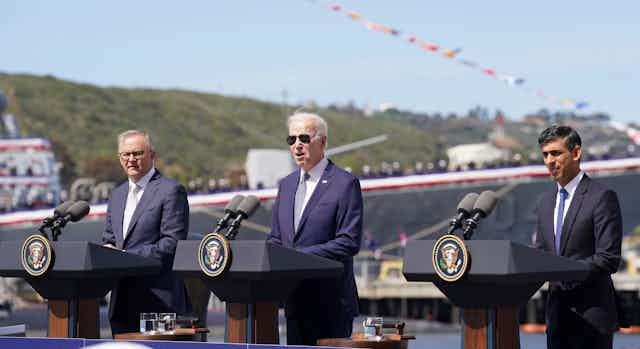The agreement to deliver Australia nuclear-powered submarines under the AUKUS tripartite security pact was announced today with great fanfare at United States Navy facilities in San Diego, California.
Prime Minister Anthony Albanese joined UK counterpart Rishi Sunak and US President Joe Biden to announce what will be the biggest defence project in Australia’s history. This momentous decision is premised on an unprecedented level of collaboration between the three countries.
Australia will buy three US “Virginia class” nuclear-powered subs (and potentially two more) as an interim measure from around 2033 onwards.
Australia will then build a new fleet of eight nuclear-powered subs onshore in Adelaide.
It’s an extraordinarily ambitious project. The estimated total cost is between A$268 billion and $368 billion over 30 years.
This plan will supply Australia with nuclear-propulsion submarines more than a decade earlier than previously envisaged.
A major part of the rationale is responding to China’s industrial-scale expansion of its military capabilities, as well as its “wolf warrior” diplomacy, exercise of sharp power (including billions in trade sanctions), and more assertive activities in the South China Sea, East China Sea and South Pacific.
So how will it all work?
The interim plan
The plan involves a number of steps.
Initially, US and UK nuclear-powered subs will visit Australian ports more regularly from 2023 to 2027.
Then, from as early as 2027, the visiting subs will form a rotational force operating out of the HMAS Stirling naval base near Perth (once that facility has been upgraded).
Meanwhile, Australian personnel will be developing their skills to build and operate these boats. Universities and TAFEs are working up from a low base to supply the workforce of up to 20,000 people required across multiple states, but largely South Australia and Western Australia.
The supply of Virginia class submarines will alleviate concerns about the shortcomings of Australia’s current fleet of “Collins class” diesel-electric subs. These are more readily detectable, and thus vulnerable, than nuclear-powered versions.
Even if we get only three Virginia class subs, this will provide a greater level of capability than the current six Collins boats. Apart from the stealth limitations, diesel-electric subs take much longer to transit to station, where their surveillance and patrolling tasks are located, and can remain on station for a shorter time.
The nuclear-powered versions move at a much greater speed underwater and are only constrained by the food supply on board.
Read more: Why nuclear submarines are a smart military move for Australia — and could deter China further
Building the next fleet
In the meantime, efforts will focus on establishing a production line in Australia for a new fleet of nuclear-powered subs, to be known as SSN-AUKUS (SSN stands for “sub-surface nuclear”). These subs will leverage design work already done by the UK and the US.
The UK will also build its own fleet of AUKUS class subs.
The separate production lines will provide complementary functions, with input from all three countries.
The new boats will include a US combat system. Australia has long relied on US combat systems for its warships, so there’s already a very high level of interoperability between the Australian and US navies.
But Australians will command the Australian vessels. Albanese was at pains to say they “will be an Australian sovereign capability”.
The UK plans to have its first AUKUS class submarine by the late 2030s. Australia won’t start receiving its locally built submarines until the early-2040s.
A changing world
Experts have raised concerns about the decline in relative power of the US vis-a-vis China. Mindful of this, in a sidebar conversation in Canberra, one senior official explained that the world where the US is less engaged is exactly the world in which we will need this capability.
In other words, the government has committed to bolster reliance on US capabilities to, ironically, bolster Australia’s own self-reliance capabilities.
In agreeing to supply Australia with US nuclear-propulsion technology, the US is acknowledging it needs to share the load, to enlist the support of Australia, in maintaining the international so-called “rules-based order” of which it was the principal progenitor.
Read more: View from The Hill: Anthony Albanese finds Scott Morrison's AUKUS clothes a good fit
Defence Minister Richard Marles explained the nuclear-powered subs plan represents a 0.15% increase in defence spending as a share of GDP.
But he assured us it wouldn’t come at the expense of other major defence capabilities that are in the pipeline.
The Defence Strategic Review is due early in April. It’s expected to address broader defence funding and acquisition plans.

